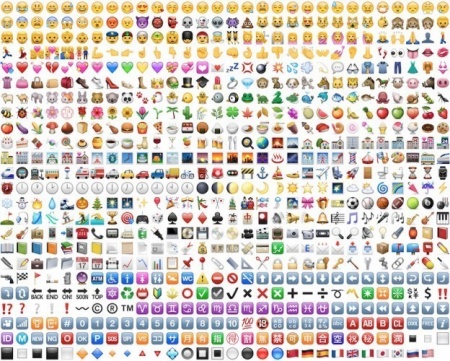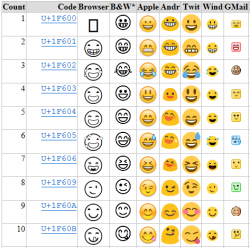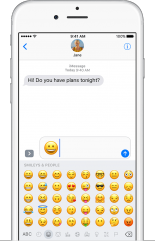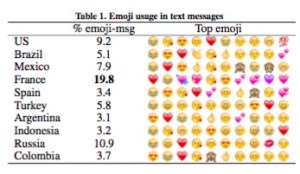Emoji
Contents
History
Emojis were first created by Japanese telecom companies in the early 1990s, during which pagers were a popular form of communication and expression amongst teenagers. NTT Domco, A Japanese phone company, was looking for a way to set itself apart from competitors to capitalize in this market. Therefore, inspired by the heart image that NTT Domco already offered in their messaging service, Shigetaka Kurita invented the emoji to offer other visualizations of emotions for use in digital communication[3]. Soon after, many other Japanese mobile companies began to offer similar characters. However, because these emojis were preloaded onto mobile phones, they wouldn't load when sent to other carriers. Therefore, the Unicode Consortium came together in 2005 to encode a standard unicode set of emojis that could be used across carriers [4]. Once adopted by Apple’s iOS5 in 2011, many others including Android, Microsoft, Google, Facebook and Twitter followed suit and have integrated emojis into their program. Though Japanese firm Unicode is responsible for picking which emoji earn their spots on the keyboard, it is still up to individual software developers to decide how each one gets visually rendered on their devices. (This explains why, for example, the gun emoji become a lime-green water gun on Apple iMessage, but is represented as an actual revolver on Microsoft phones.) [5]
Versions
In August 2016, Unicode released its first major package of emoji documentation, which included all icons approved between 2010 and 2015 (including certain characters from Unicode 6.0, Unicode 6.1, Unicode 7.0 and Unicode 8.0). Prior to this release, no major software vendors supported emojis from Unicode 7.0 or newer. [6]
In November 2015 (just three months after Emoji 1.0 released), Unicode launched this initial update to specify which emojis should utilize the skin tone modifier. Emoji 2.0 offers a diverse range of modern family dynamic combinations (such as "Man, Man, Boy" and "Woman, Woman, Boy"). This update represents the first serious effort by Unicode to diversify its characters [7]
In June 2016, Unicode simultaneously released Emoji 3.0 and Unicode 9.0. This release recommended which of the Unicode emojis should support multiple different variations of skin tones and continued enacting Unicode's mission to diversify its character-base. [8]
On November 28, 2016, Unicode released Emoji 4.0, a new batch of characters with a far more inclusive agenda. Emoji 4.0 brought more gender-neutral emojis than its predecessors, including 16 new emoji professions, a Rainbow Flag, and a United Nations Flag. [9] All professions can be set to feature either a male or a female in its specified role, which is considered critically important to female equality efforts internationally. [5]
In June 2017, Unicode is expected to release a set of 70+ emoji that will represent a fifth generation of the characters. Emoji 5.0 is expected to include icons of fantasy creatures (such as fairies, genies, vampires, wizards, zombies and more), previously unlisted foods (fortune cookie, wontons, a freshly baked pie, a sandwich, and a pretzel), and newly represented versions of humans (including a breastfeeding women, older people, people who wear headscarves, a vomiting face, a cursing face, a face with stars for eyes, and more). [10]
Sometime in 2019, 230 new emojis will be released with the new iOS software update 12.2. The Unicode Consortium recently approved the new emojis for release. Some of the new emojis will include a service dog, flamingo, and a sari. With each new release, the scope of people being represented broadens. Gender inclusive couple emojis, disabled persons emojis, and emojis that permit a wide variety of skin tones for people holding hands. [11]
Usage & Communication
Since their introduction, emojis quickly emerged into everyday discourse and transformed traditional electronic communication. Emojis are widely used on social media and in digital messaging, with over 74% of Americans and 82% of Chinese saying they have used them in messaging apps[12]. People mostly tend to use emojis that depict facial expressions and body signals, of which the "Face with Tears" emoji ("😂") is the most used, followed by the red heart emoji, and the "Smiling Face with Heart-eyes" emoji ("😍")[13].
When used in communication, emojis enable users to shorten input [13] into messages that would otherwise require more thorough explanation [14], and enhance understanding by offering graphic annotations of visual cues and voice recognition typically present face-to-face and in speech. Beyond strengthening comprehension of one another, emojis also allow for improved cross-cultural communication and understanding as they are a "ubiquitous language"[13] whose illustrations can transcend language barriers [15].
While emojis have fostered understanding among individuals around the world, emojis can also be ambiguous and cause miscommunication. Though they have specific definitions, the interpretation of an emoji's meaning may differ from one person to the next. This miscommunication can occur when trying to express humor or sarcasm, especially when an emoji has double-meaning used to express two different things. For example, the Eggplant emoji ("🍆"), can represent a literal eggplant, but is also commonly used as a sexual innuendo[12], particularly by Americans. Not only are specific emojis used more frequently in certain countries over others, but emojis meaning can differ according to culture.
Platforms that do not support the use of emojis force users to create expressions using typical characters found on a keyboard. A compilation of characters can be used together in order to form the desired expression. An example of common combinations are :) , ;) , D: , :D , etc,.
Bitmojis
Bitmoji is a free service that allows users to create customized emojis. These characters work less like traditional text insert emojis, and are more like stickers or avatars for a user. The user can upload a photo of them self and then choose from color and style options of facial features and hair and clothes, to design an 'emoji' character that is personalized to resembles them. Bitmojis are commonly used on Snapchat and bitmoji stickers or emojis feature your character in a variety or poses, emotions, and facial expressions.
Film
In 2017 an animated comedy was released called The Emoji Movie. The movie saw actors T.J Miller, James Corden, Anna Faris, Maya Rudolph, Christina Aguilera, and Sofia Vergara voice different emojis. The story follows an emoji that lives in a teenagers smartphone that is on a journey to figure out his identity. The Emoji Movie premiered on July 23, 2017 and was produced by Sony Pictures Animation [16]. The film made $217 million, however, the movie received poor reviews and has 7% on Rotten Tomatoes [17].
Culture
Usage
The most frequently used emojis tend to differ from one culture to the next. People in France and Russia have a greater tendency to use emojis related to love. Meanwhile, Australians are more likely to use emojis related to drugs and alcohol [18].
The website Emjoitracker.com allows for people to track which emoji's are most commonly used on Twitter.[19]
Meaning
The meaning of certain emojis can also often differ from one culture to another. Much of this difference occurs in translation from eastern to western culture. Since emojis originated in Japan, the meaning of an emoji specific to eastern culture may have evolved to imply something else in the West. For example, the "Women with Bunny Ears" emoji ("👯") is often taken to mean fun or "let's party" to the Western world, though it was originally purposed to refer to the equivalent of Playboy Bunnies in Japanese culture [20]. Another example is the "Information Desk Person" (💁) emoji, which is commonly interpreted in America as a hair flip emoji as opposed to a woman offering help or information [21]. This cultural difference in interpretation extends to other cultures around the world, such as the "Thumbs Up" ("👍") emoji which represents a job-well done in western culture, but implies the Western equivalent of the middle-finger to people in Russia, the Middle East, West Africa, and South America [15]. The person with folded hands ("🙏") often is supposed to mean thank you or please. Many times in Western areas, this emoji is taken as a prayer or is sometimes confused as a high five.[15]
Ethics
Emoji usage raises ethical concerns relating to literacy and miscommunication. Emoji's integration into digital communication signifies the shift in traditional methods of reading and writing. Furthermore, emojis imply a change in the human consciousness and how it processes information, as it used to process textual information more literally, but is now able to process information more imaginatively[13] through the open interpretation of the pictorial annotations.
Open interpretations of emojis can lead to miscommunication amongst users who place different meaning on emojis than intended by either the sender or from the actual significance of the emoji. Texts sent from one person to another via an electronic device, the sender's intentions of an emoji can be skewed based on the meaning that is picked up by the receiver. This miscommunication can lead to many consequences, ranging from negligible to catastrophic.
Controversy
Emojis have been subject to a wide variety of controversy regarding their representation of race, gender, violence, etc. For example, in Apple's release of iOS10 in 2016, Apple changed the pistol emoji to a water gun, put female faces in stereotypical male jobs and sports[22], and similarly added male versions of stereotypically female roles such as that of the dancing women with bunny ears. The iOS 10 update also introduced the rainbow flag which correlated to Apple's public commitment to diversity and the support of causes. [23] Apple's response speaks to the limits of online representation. Through these changes, it shows how much impact societal norms have on a company and the technology involved. Apple is only one of the many companies that have emojis, however, and many of the other technology companies have not yet diversified their set of emojis.
Race
Before 2015, many people complained that emoji faces were under-representing certain groups with darker skin tones, since all emojis used white faces. In April of 2015, Apple released emojis in 6 different skin colors in response to these complaints and in an effort to promote diversity. [24] Since the addition of these emojis with skin tones, there have also be questions regarding the use of skin tones by people of different races. An author in The Atlantic questioned why they didn't see much use of the emoji with the lightest skin, even by those who are light-skinned. [25] There have also been questions about whether it is considered cultural appropriation if white people use emojis with darker skin tones. [25] Ann Friedman, a host of the podcast Call Your Girlfriend, concluded that it depends on in what context you are using the emoji-whether you are using the emoji as a direct representation of yourself, or a persona separate from yourself.[25]
Disabilities
Originally, most emojis available were able-bodied. Apple has currently introduced a campaign to introduce emojis with disabilities. [26] For example, thirteen new emojis include a person in a wheelchair. Including emojis which represent people with disabilities is to diversify the options on the emoji keyboard and provide more inclusive options for users. [27] By having these relatable options, this increases the likelihood of others using emojis for their form of communication and fostering a culture of inclusivity, especially in tech.
Violence
In lieu of the recent controversies surrounding gun violence and gun control, Apple changed the gun emoji from an actual pistol to a water gun. While gun control groups supported the conversion as it showed Apple taking a stance for more gun control. The backlash surrounding this switch revolved it being seen as inconsequential as it did not reduce crime or reduce the amount of shootings. Another problem that arose was that this water gun switch was only on Apple, so if an iMessage user uses the emoji, there's no guarantee that the gun will be seen as a water gun on an Android if the software hasn't been updated, rendering the update almost useless. Although, there have been cases where using certain emoji have had real consequences. Along with the gun emoji, several other weapon emojis have been regularly used to threaten people. For example, a 12-year-old girl faced criminal charges for posting the following in an Instagram caption that was interpreted to be threatening her school:[28]
Killing 🔫 “meet me in the library Tuesday” 🔫 🔪 💣
Other cases include a grand jury in New York City that had to decide if 👮🔫🔫🔫 that a teen posted was a real threat to police officers, a Michigan judge who was asked to interpret the meaning of :P, and even a case that reached the Supreme Court over what qualifies as a threat.[28]
Emojis as Part of Evidence in Court
In a 2015 trial at the Federal District Court in New York City, Ross W. Ulbricht was being charged with managing an online black-market bazaar called Silk Road, allowing customers to purchase drugs and illicit goods from vendors. As a federal prosecutor finished reading the text of an internet post, Ulbricht's lawyer raised an objection, saying a smiley face emoji at the end of the post was wrongly omitted from the reading despite being part of the evidence. The lawyer argued that chats were designed to be seen and read, not heard, and that certain forms of writing, such as "???", all capital letters, distorted words like "soooo", and emoticons, couldn't be reliably conveyed orally in court. As a result, he asked all chats involved in the case to be shown to the jury before the trial instead of read out loud.[29]
This case revealed questions about how chats, messages, and symbols should be presented in court, as well as how jurors should be taught about unfamiliar terms like Bitcoin, a virtual currency used to conduct Silk Road transactions, and Tor network, where online activity is anonymous. Lack of understanding about these technical terms and context of emoji-usage raised questions about whether the jury could make the best decisions. This demonstrates that as new technology arises, new rules and regulations also have to evolve to keep up.
(^ Citation from class readings is required here, but I can't remember which reading this idea is from.)
Emoji versus Formal Language
Another concern about the increasingly popular use of emojis is that it might harm a user's ability to use formal language, especially for the younger generations. With the increasing popularity of using emojis in place of words and sentences in communications, it raises concerns about whether formal human languages are losing their significance and whether the younger generation will gradually lose ability to communicate by using formal languages correctly. Whether or not these consequences will be positive or negative, we know that there is going to be a change that arises from the use of emojis. These potential consequences are difficult to predict, in part because of the universal explanations of emojis. [30]
Children and Emojis
With the increase in young children owning smart devices such as iPads, iPods, and iPhones with messaging capabilities, emoji use in certain contexts sparks another concern. Some researchers have claimed that emoji use can aid in a children's learning to communicate, by helping them express themselves via the use of emojis. [31] However, many teens are utilizing emojis to convey sexual and other inappropriate messages. For example, the use of the eggplant or peach emoji conveys sexual innuendos inappropriate for young children. The electrical plug emoji can reference someone who sells drugs, often referred to as 'the plug.' Many parents are unaware what the secret meanings behind these popular emojis are, so they may also be unaware of dangerous or inappropriate behavior their children might be involved in. [32]
References
- ↑ "Emojipedia.org", Emojipedia. Emoji Statistics. Web. 04 Apr. 2017.
- ↑ Hamilton, Bevan. "Emojis: Are They Changing How We Communicate with Each Other?", CBCnews. CBC/Radio Canada, 04 Apr. 2017.
- ↑ Blagdon, Jeff. "How Emoji Conquered the World.", The Verge. Vox Media, Inc.", 04 Mar. 2013.
- ↑ Y., Y. "What Emoji Are.", The Economist Newspaper. The Economist, 21 July 2015. Web. 04 Apr. 2017.
- ↑ 5.0 5.1 Titcomb, James. "New 'gender Equality' Emoji to Show Women at Work." The Telegraph. Telegraph Media Group, 15 July 2016.
- ↑ "Emojipedia.org", Emojipedia. Emoji Version 1.0. Web. 11 Apr. 2018.
- ↑ "Emojipedia.org", Emojipedia. Emoji Version 2.0. Web. 11 Apr. 2018. /
- ↑ "Emojipedia.org", Emojipedia. Emoji Version 3.0. Web. 11 Apr. 2018. /
- ↑ "Emojipedia.org", Emojipedia. Emoji Version 4.0. Web. 11 Apr. 2018. /
- ↑ Kircher, Madison Malone."Merman and Breastfeeding Woman Among 69 Emoji Coming Soon to a Keyboard Near You." Select All. N.p., n.d
- ↑ Burge, J. 230 New Emojis in Final List for 2019. Feb 2019. https://blog.emojipedia.org/230-new-emojis-in-final-list-for-2019/
- ↑ 12.0 12.1 Sternbergh, Adam. Smile, You're Speaking Emoji: The Rapid Evolution of a Wordless Tongue. 16 Nov. 2014. Web. "Daily Intelligencer. New York Media, LLC"
- ↑ 13.0 13.1 13.2 13.3 Lu, Xuan, Wei Ai, Xuanzhe Liu, Qian Li, Ning Wang, Gang Huang, and Qiaozhu Mei. Learning from the Ubiquitous Language. 12 Sept. 2016. "Proceedings of the 2016 ACM International Joint Conference on Pervasive and Ubiquitous Computing - UbiComp '16 (2016): n. pag. Ubicomp '16."
- ↑ Waude, Adam. Do Emoticons Help Us To Better Communicate Emotions? 29 Apr. 2016. "Psychologist World"
- ↑ 15.0 15.1 15.2 Danesi, Marcel. The Semiotics of Emoji: The Rise of Visual Language in the Age of the Internet. London: Bloomsbury, 2017. Print
- ↑ The Emoji Movie, https://www.imdb.com/title/tt4877122/?ref_=nv_sr_1?ref_=nv_sr_1
- ↑ https://www.rottentomatoes.com/m/the_emoji_movie
- ↑ Murphy, Samantha. America Leads the World in Cake and Meat Emoji. 22 Apr. 2015. "Mashable"
- ↑ "Emoji Twitter Tracker" "Emoji Tracker"
- ↑ Emojipedia. 👯 Woman With Bunny Ears Emoji. n.d. Web. 04 Apr. 2017. "Emojipedia"
- ↑ 10 Emoji Meanings That Don't Mean What You Think They Mean https://www.lifewire.com/less-obvious-emoji-meanings-3485884
- ↑ Kelly, Heather Apple replaces the pistol n.d. Web. 06 Apr. 2017. "CNN"
- ↑ Griffin, Andrew. “IOS 10: Apple Replaces Gun Emoji with a Water Pistol, and Adds Male Versions of Dancing Cat Women.” The Independent, Independent Digital News and Media, 2 Aug. 2016.
- ↑ Tutt, Paige Apple's New Diverse Emoji n.d. Web. 06 Apr. 2017. "Washington Post"
- ↑ 25.0 25.1 25.2 McGill, Andrew. "Why White People Don't Use White Emoji" The Atlantic (9 May 2016. Retrieved 23 April 2017).
- ↑ Gallucci, Nicole. “Apple Proposes 13 New Emoji That Represent People with Disabilities.” Mashable, Mashable, 23 Mar. 2018.
- ↑ Potenza, Alessandra. “Why We Need Emoji Representing People with Disabilities.” The Verge, The Verge, 3 Apr. 2018.
- ↑ 28.0 28.1 Jouvenal, J. (2017). A 12-year-old girl is facing criminal charges for using emoji. She's not alone. The Washington Post. Retrieved 9 April 2017, from https://www.washingtonpost.com/news/local/wp/2016/02/27/a-12-year-old-girl-is-facing-criminal-charges-for-using-emoji-shes-not-alone/?utm_term=.e1621bcc6b62
- ↑ Weiser, B. (2015). At Silk Road Trial, Lawyers Fight to Include Evidence They Call Vital: Emoji. The New York Times. Retrieved 9 April 2017, from https://www.nytimes.com/2015/01/29/nyregion/trial-silk-road-online-black-market-debating-emojis.html
- ↑ Joan, Gage. (2015). Are Emoticons And Emojis Destroying Our Language? from http://www.huffingtonpost.com/joan-gage/emoticons-and-emojis-destroying-our-language_b_7950460.html
- ↑ McCulloch, G. Children are using Emojis for Digital-Age Language Learning. Wired. 2019. https://www.wired.com/story/children-emoji-language-learning/
- ↑ Roberts, K. Parents, Do You Know the Most Common Emojis Used in Sexting? EducateEmpowerKids.org. 2018. https://educateempowerkids.org/common-emojis-used-in-sexting/



